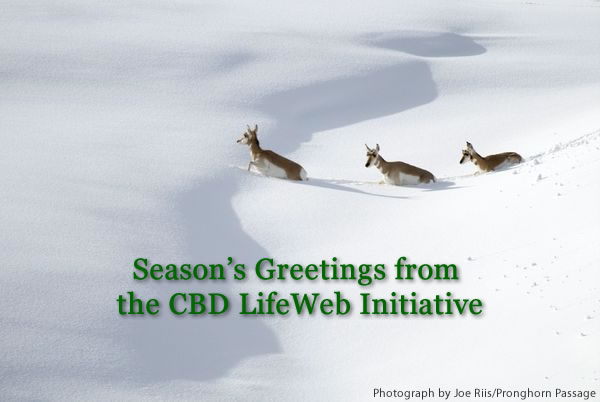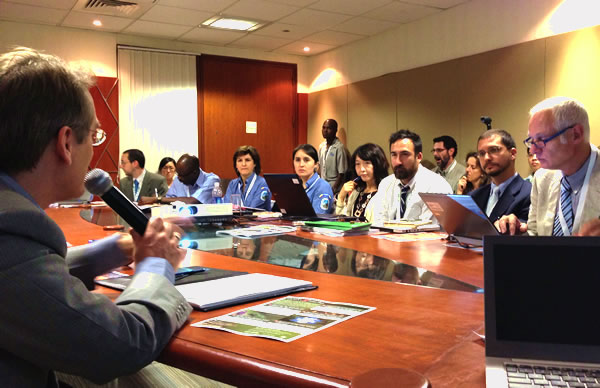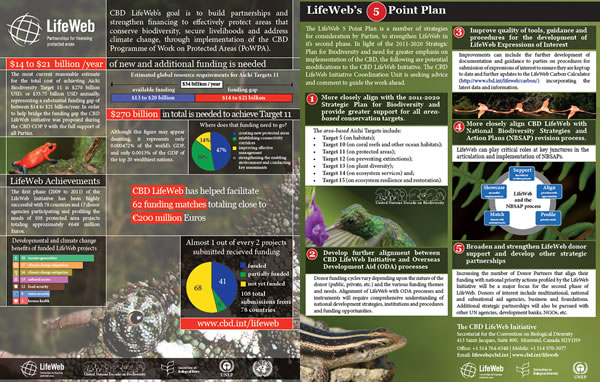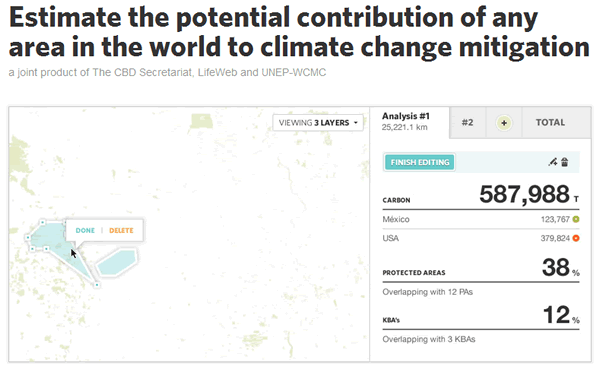
| DECEMBER 2012 |
Season’s Greetings from the CBD LifeWeb Initiative Team!
Since its inception, the CBD LifeWeb Initiative has helped facilitate 62 funding matches totalling close to €200 million Euros. Despite the many successes in strengthening protected areas and and expanding their coverage, there is a great deal more work to be done, and the CBD LifeWeb Initiative has been working hard to maximize its impact. This newsletter will update you on some of the major changes taking place in 2013 as we enter a new phase.
2012 was a significant year for the CBD LifeWeb Initiative as we received a new coordinator and we started planning for a new phase that will lead to more funding matches and stronger partnerships in the years ahead.
| » | Visit the CBD LifeWeb Website: www.cbd.int/lifeweb |
Charles Besancon joined the Montreal-based CBD Secretariat in August to coordinate the CBD LifeWeb Initiative. He has a long history of working on protected areas issues at the national and international level. For the past 6 years he was the Head of the Protected Areas Programme at the UNEP World Conservation Monitoring Centre in Cambridge, UK where he led the team that developed Protectedplanet.net, the Protected Planet Report and the World Database on Protected Areas among other projects. Before that he was working on global transboundary conservation issues at his base in Cape Town South Africa. He is excited about this opportunity with the CBD Secretariat to turn his attention toward strengthening protected area implementation.
“One of the greatest challenges we are facing in conservation is the large funding gap. Using the platform of the Convention on Biological Diversity I look forward to making a significant difference in closing that gap and speeding implementation of the many decisions that Parties to the Convention have made that require well managed protected areas. CBD LifeWeb Initiative is an excellent example of how partnerships between developing and developed countries can make a significant difference in achieving sustainable development.”
| » | Say hi to Charles, email him at charles.besancon@cbd.int |
The eleventh meeting of the Conference of the Parties (COP 11) was held in Hyderabad, India, from 8 to 19 October 2012.
In COP 11 decision XI/24 on protected areas, the CBD LifeWeb Initiative was noted as playing in important role in aligning available funding with action plans and organizing donor round table meetings. This decision also encourages Parties to make use of the CBD LifeWeb Initiative as a platform to communicate funding needs for the implementation of CBD Program of Work on Protected Areas Action plans. The CBD LifeWeb Initiative was requested in decision XI/24 to support mobilization of funding for implementation of PoWPA action plans by holding national, subregional and regional donor round table meetings taking into account funding needs assessments, financial planning and funding strategies in PoWPA action plans.
The CBD LifeWeb Initiative will facilitate more roundtable meetings to work towards aligning available funding with National Action Plans.
| » | COP 11 Decisions | Earth Negotiations Bulletin Summary Report | COP 11 Photos on Flickr |
The first phase (2009 to 2011) of the CBD LifeWeb Initiative has been highly successful with 78 countries and 17 donor agencies participating and profiling the needs of 102 protected area projects totaling approximately €648 Million Euros. The CBD LifeWeb Initiative has helped facilitate 62 funding matches totaling close to €200M Euros for the expansion and strengthening of national and regional protected area systems toward the achievement of Aichi Biodiversity Target 11 and related targets.

The majority of LifeWeb matched projects have contributed towards achieving developmental goals in many developing countries.


CBD LifeWeb Initiative funding matches to-date have focused significantly on improving the effective management of protected areas in order to help secure the vital ecosystem services that greatly improve human health and well-being for human and wildlife populations (Aichi Target 14).

Despite the many successes in strengthening existing protected areas and increasing coverage, there is a great deal more work to be accomplished to achieve Aichi Target 11.
| » | Read the LifeWeb COP 11 Information Document |
Consultation on a new phase for the CBD LifeWeb Initiative began in the lead up to the 11th meeting of the Conference of the Parties to the Convention on Biological Diversity. An information document was published reviewing progress and providing options for a second phase. At the 11th Conference of the Parties in Hyderabad, India, the options for the CBD LifeWeb Initiative were reviewed at a Side Event and additional consultations with donors and partners followed in November 2012 throughout Europe.
The result of the consultation has revealed the need to much more closely align the CBD LifeWeb Initiative with the Strategic Plan for Biodiversity 2011-2020 and the development of updated National Biodiversity Strategies and Action Plans (NBSAPs).
Thus far, the CBD LifeWeb Initiative has considered projects that directly support the CBD Programme of Work on Protected Areas and Target 11 of the Strategic Plan for Biodiversity 2011-2020. Based upon the consultation with Parties, donors, partners and recipients, the CBD LifeWeb Initiative will be expanding the scope of its support to include all area-based Aichi Biodiversity Targets from the Strategic Plan for Biodiversity 2011-2020. This includes:
- Target 5 (on habitats);
- Target 9 (on invasive alien species eradication);
- Target 10 (on coral reefs and other ocean habitats);
- Target 11 (on protected areas);
- Target 12 (on preventing extinctions);
- Target 13 (on genetic diversity);
- Target 14 (on ecosystem services) and;
- Target 15 (on ecosystem resilience and restoration)
National Biodiversity Strategies and Action Plans are the mechanisms by which Parties to the Convention express their priority actions necessary for achievement of goals and targets in the Strategic Plan. For developing countries these actions will often require external financing. The CBD LifeWeb Initiative in its second phase will work closely with Parties to ensure that Expressions of Interest are consistent with their priority actions identified through NBSAPs to create better alignment between international frameworks and action on the ground and at sea.
In early 2013, a CBD notification will be sent to all National Focal Points and Programme of Work on Protected Areas Focal Points seeking new Expressions of Interest to LifeWeb in the context of the area-based Aichi Targets from the Strategic Plan for Biodiversity 2011-2020 and fully aligned with National Biodiversity Strategies and Action Plans.
You can expect to see an improved the CBD LifeWeb Initiative website interface in early 2013, new guidance for donors and recipients and new and improved templates for Expressions of Interest. Donors have generally found Expressions of Interest to be very informative, but we are striving to improve their quality in order to clarify project goals and major initiatives so that we can better align these projects with the right donors. This will include a new requirement for funded projects to report on challenges, success and accomplishments of a conservation project post-funding.
Integrating all area-based conservation targets and aligning the CBD LifeWeb Initiative with the NBSAP revision process is part of LifeWeb’s 5 Point Plan.
| » | Read the CBD LifeWeb Initiative's 5 Point Plan |
The carbon calculator has proved to be a useful tool in demonstrating links for restoration, climate change mitigation and biodiversity protection. We believe that the Carbon Calculator can do much more by providing this same information, but far more accurately. Our vision is to update the calculator so that it can dynamically analyze user-defined polygons to provide information that can be not only demonstrated but also used for making decisions at a national or local level. We aim to launch the next phase of the Carbon Calculator by April 2013 with the support of the UK Department for Environment, Food and Rural Affairs (DEFRA).
Please send all queries to lifeweb@cbd.int
| » | For more information visit: www.cbd.int/lifeweb/carbon |
| » | View all expressions of interest: www.cbd.int/lifeweb/search/ |
UNEP/CBD/COP/11/24 Protected Areas: Progress in the Implementation of the Programme of Work and Achievement of Aichi Biodiversity Target 11
UNEP/CBD/COP/11/INF/48 The CBD LifeWeb Initiative: The LifeWeb Initiative: A Review of Progress and Options for the Future
TEEB Implementation Guide for Aichi Target 11 A practical guide for governments for integrating the economic, social and cultural value of ecosystems into national biodiversity plans.
Catalysing Ocean Finance The report demonstrates how a modest investment of public finance can reverse the global decline in ocean health.
Resource requirements for Aichi Targets 11 – Protected Areas This report estimates the cost of implementing Target 11, including the costs of a) creating new protected areas; b) establishing connectivity corridors; c) effectively managing new and existing protected areas; d) strengthening protected area enabling environments and sustainable finance; and e) conducting key protected area assessments.
Quick guide to the Aichi Biodiversity Targets - Protected areas increased and improved Well-governed and effectively managed protected areas are a proven method for safeguarding both habitats and populations of species and for delivering important ecosystem services. Particular emphasis is needed to protect critical ecosystems such as tropical coral reefs, sea-grass beds, deepwater cold coral reefs, seamounts, tropical forests, peat lands, freshwater ecosystems and coastal wetlands. Additionally, there is a need for increased attention to the representativity, connectivity and management effectiveness of protected areas.
Protected Areas for the 21st Century: Lessons from UNDP/GEF's Portfolio The following report looks at how changing 21st Century expectations about the roles and functions of protected areas are beginning to shape protected area management around the world and identifies emerging best practices for protected areas under a new paradigm that views protected areas as part of a planetary life support system.
Protected Planet Report 2012 The Protected Planet Report 2012 reviews progress towards the achievement of international protected area targets.
| » | For more tools and documents visit: /www.cbd.int/protected/tools/ |
The goal of the CBD LifeWeb Initiative is to build partnerships and strengthen financing to effectively protect areas that conserve biodiversity, secure livelihoods and address climate change, through implementation of the CBD Programme of Work on Protected Areas (PoWPA) and the achievement of the area-based Aichi Targets from the Strategic Plan for Biodiversity 2011-2020.
For more information, please visit www.cbd.int/lifeweb
| » | www.cbd.int/lifeweb | lifeweb@cbd.int | facebook | twitter |










